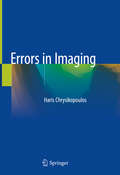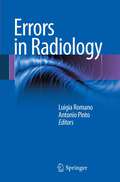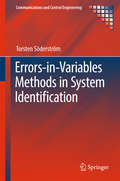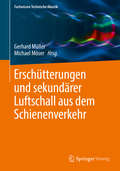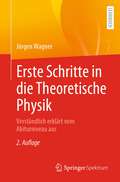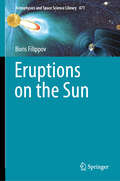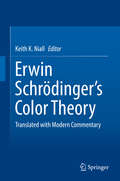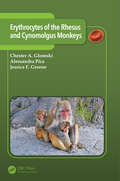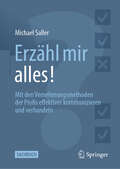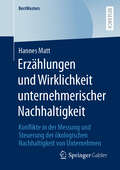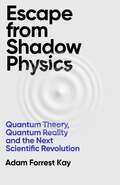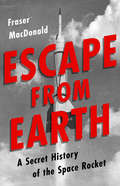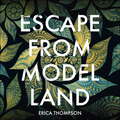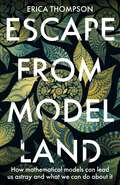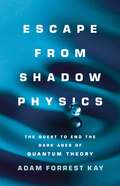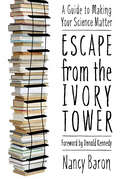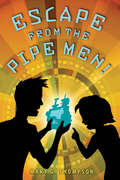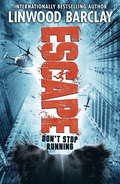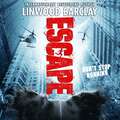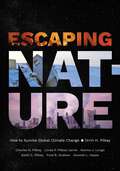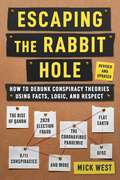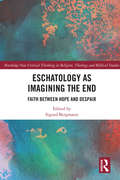- Table View
- List View
Errors in Imaging
by Haris ChrysikopoulosThis book offers a thorough, clear and practical guide to identifying, preventing and correcting any error or bias that may arise during the interpretation and reporting of medical images. It combines information and insights from the fields of radiology, expertise theory, cognitive psychology, and advanced learning practices with the author’s considerable clinical (radiologic) experience. In addition, the book features an extensive “Teaching Cases Section” that simulates real-world situations, giving readers an opportunity to practice what they have just learned. The purpose of the book is to provide readers with essential information and strategies, and to point out the deficiencies of the current radiology education system, in order to minimize the occurrence and the clinical impact of errors in imaging by offering the proper education and training for imaging professionals. It offers a valuable guide for diagnostic radiologists and all other imaging professionals, whether in training or in practice. Though the main emphasis is on computed tomography and magnetic resonance, the general principles are applicable to all conventional imaging modalities.
Errors in Radiology
by Antonio Pinto Luigia RomanoDiagnostic errors are important in all branches of medicine because they are an indication of poor patient care. As the number of malpractice cases continues to grow, radiologists will become increasingly involved in litigation. The aetiology of radiological error is multi-factorial. This book focuses on (1) some medico-legal aspects inherent to radiology (radiation exposure related to imaging procedures and malpractice issues related to contrast media administration are discussed in detail) and on (2) the spectrum of diagnostic errors in radiology. Communication issues between the radiologists and physicians and between the radiologists and patients are also presented. Every radiologist should understand the sources of error in diagnostic radiology as well as the elements of negligence that form the basis of malpractice litigation.
Errors-in-Variables Methods in System Identification (Communications and Control Engineering)
by Torsten SöderströmThis book presents an overview of the different errors-in-variables (EIV) methods that can be used for system identification. Readers will explore the properties of an EIV problem. Such problems play an important role when the purpose is the determination of the physical laws that describe the process, rather than the prediction or control of its future behaviour. EIV problems typically occur when the purpose of the modelling is to get physical insight into a process. Identifiability of the model parameters for EIV problems is a non-trivial issue, and sufficient conditions for identifiability are given. The author covers various modelling aspects which, taken together, can find a solution, including the characterization of noise properties, extension to multivariable systems, and continuous-time models. The book finds solutions that are constituted of methods that are compatible with a set of noisy data, which traditional approaches to solutions, such as (total) least squares, do not find. A number of identification methods for the EIV problem are presented. Each method is accompanied with a detailed analysis based on statistical theory, and the relationship between the different methods is explained. A multitude of methods are covered, including: instrumental variables methods; methods based on bias-compensation; covariance matching methods; and prediction error and maximum-likelihood methods. The book shows how many of the methods can be applied in either the time or the frequency domain and provides special methods adapted to the case of periodic excitation. It concludes with a chapter specifically devoted to practical aspects and user perspectives that will facilitate the transfer of the theoretical material to application in real systems. Errors-in-Variables Methods in System Identification gives readers the possibility of recovering true system dynamics from noisy measurements, while solving over-determined systems of equations, making it suitable for statisticians and mathematicians alike. The book also acts as a reference for researchers and computer engineers because of its detailed exploration of EIV problems.
Erschütterungen und sekundärer Luftschall aus dem Schienenverkehr (Fachwissen Technische Akustik)
by Michael Möser Gerhard MüllerDieser Band der Reihe Fachwissen Technische Akustik behandelt die Entstehungsmechanismen und die Minderung von Erschütterungen und sekundärem Luftschall aus dem Schienenverkehr. Aufbauend auf den Erkenntnissen des Luftschalls aus dem Schienenverkehr wird auf deren Bewertung sowie auf Prognoseverfahren eingegangen.
Erste Schritte in die Theoretische Physik: Verständlich erklärt vom Abiturniveau aus
by Jürgen WagnerDieses Lehrbuch bietet einen einfachen Zugang zur Theoretischen Physik und realisiert einen durchgängigen Anschluss an die in der Schule erworbenen physikalisch-mathematischen Vorkenntnisse. Aus seiner Erfahrung als Diplomlehrer für Physik und Mathematik heraus ebnet der Autor den Weg in die Theoretische Physik. Er stützt sich dabei auf die folgenden Prinzipien: Viele Abbildungen und detailliert vorgerechnete Beispiele tragen wesentlich zum Verständnis der Darstellungen bei. Verwendete „Rechentricks“ werden angegeben und erläutert.Die erforderliche Mathematik wird schrittweise und ausführlich erarbeitet.Die Struktur des Lehrbuchs orientiert sich an folgenden zentralen Phänomenen und Grundbegriffen: Bewegung, Elektrizität und Magnetismus, Relativität sowie Quanten. In diesem Rahmen werden die üblichen Inhalte der Module Theoretische Mechanik, Elektrodynamik, Relativitätstheorie und Quantenmechanik verortet.Die experimentelle Basis für theoretische Ansätze wird explizit benannt, um die Besonderheiten der naturwissenschaftlichen Methode zu betonen, die sich von Autoritätsgläubigkeit sowie Spekulation deutlich abgrenzt.Auf bestehende Interpretationsprobleme der Quantenmechanik wird ausdrücklich hingewiesen. Begriffe wie „Welle-Teilchen-Dualismus“ oder „Kollaps der Wellenfunktion“ werden vermieden, da sie Missverständnisse provozieren können.Dieses Buch richtet sich an Studierende der Natur- und Ingenieurwissenschaften sowie des Lehramts, zu deren Studieninhalten mindestens ein Modul Theoretische Physik gehört. Es wendet sich auch an alle, die sich für Fragestellungen der Naturwissenschaften oder Naturphilosophie interessieren und über eine positive Einstellung zur Mathematik verfügen.Die vorliegende zweite Auflage wurde um ein Kapitel zum Phänomen Wärme mit Inhalten aus der klassischen und statistischen Thermodynamik erweitert sowie an zahlreichen Stellen ergänzt und verbessert.
Eruptions on the Sun (Astrophysics and Space Science Library #471)
by Boris FilippovThis book is devoted to eruptive phenomena on the Sun, the most dangerous sources of space weather disturbances. It discusses the latest achievements in this field, described in the scientific literature and obtained by the author himself. The initial chapters of the book give a brief description of the role of the Sun in the life and history of mankind, a general description of the solar interior and the atmosphere of the Sun, the causes and drivers of solar activity and its impact on the Earth's environment and human life. The book provides a detailed description of eruptive phenomena on the Sun, a review of observations of solar activity and theoretical ideas about the mechanisms and causes of a sudden release of energy in the solar atmosphere. Much attention is paid to the solar magnetic fields, their characteristic features and measured values in the photosphere, the observed manifestations in the chromosphere and corona, and methods for extrapolating photospheric data to the upper layers of the solar atmosphere. It is assumed that the magnetic field is the source of energy suddenly released during eruptive phenomena observed in the form of flares, prominence eruptions and coronal mass ejections (CMEs). Energy is accumulated and stored in the non-potential (associated with electric currents) part of the coronal magnetic field (free magnetic energy). This part of the field is the most variable and can provide energy for fast eruptive processes. CMEs, propagating through the interplanetary medium, significantly perturb it and cause the strongest geomagnetic storms when they affect the Earth's magnetosphere. The prediction of the arrival of the CME is the key problem of the entire space weather forecast. Thus, pre-eruptive conditions in CME source regions are of great importance. Solar prominences and filaments are considered the most likely progenitors of CMEs. Most of the book is devoted to the description and analysis of their equilibrium and stability. It is shown that there are measurable characteristics of the proximity of the prominence to the instability threshold, which can be very useful in the problem of space weather forecasting. The book contains many illustrations and links to the latest scientific articles and reviews on the topic. It will be useful to researchers in the field of astrophysics, solar physics, geophysics, as well as PhD and graduate students.
Erwin Schrödinger's Color Theory: Translated with Modern Commentary
by Keith K. NiallThis book presents the most complete translation to date of Erwin Schrödinger’s work on colorimetry. In his work Schrödinger proposed a projective geometry of color space, rather than a Euclidean line-element. He also proposed new (at the time) colorimetric methods – in detail and at length - which represented a dramatic conceptual shift in colorimetry. Schrödinger shows how the trichromatic (or Young-Helmholtz) theory of color and the opponent-process (or Hering) theory of color are formally the same theory, or at least only trivially different. These translations of Schrödinger’s bold concepts for color space have a fresh resonance and importance for contemporary color theory.
Erythrocytes of the Rhesus and Cynomolgus Monkeys
by Chester A. Glomski Alessandra Pica Jessica F. GreeneErythrocytes of the Rhesus and Cynomolgus Monkeys addresses the morphologic, quantitative, and generative aspects of the erythrocytes of the rhesus monkey Macaca mulatta and the cynomolgus monkey Macaca fascicularis (long-tailed macaque, crab-eating monkey). These two species are the most commonly selected nonhuman primates for basic science and cl
Erzähl mir alles!: Mit den Vernehmungsmethoden der Profis effektiver kommunizieren und verhandeln
by Michael SallerDieses Buch bietet Einblicke in die speziellen Techniken, mit denen Profis bei Vernehmungen und Befragungen die gewünschten Informationen erhalten, und erklärt, wie sie für die tägliche Kommunikation genutzt werden können. Der erste Teil erläutert die Unterschiede zwischen Vernehmung und Befragung, stellt Methoden zur Bewertung von Aussagen vor und diskutiert zwei prominente Fälle aus dem Strafrecht (Kachelmann, Mollath). Der zweite Teil konzentriert sich auf bewusste Lügen von Befragten und beschreibt, wie die Glaubwürdigkeit von Personen und die Glaubhaftigkeit von Aussagen methodisch analysiert werden. Der dritte Teil behandelt den Umgang mit Erinnerungen und Irrtümern bei Zeugenaussagen. Der vierte Teil zeigt ein sechsphasiges Modell der effizienten Informationsgewinnung mit praktischen Beispielen und bietet 30 Expertentipps für informativere Gespräche.
Erzählungen und Wirklichkeit unternehmerischer Nachhaltigkeit: Konflikte in der Messung und Steuerung der ökologischen Nachhaltigkeit von Unternehmen (BestMasters)
by Hannes MattIn der Fachliteratur herrscht die Diagnose vor, dass die gegenwärtigen Methoden und Standards für das unternehmerische Nachhaltigkeitsmanagement nicht dazu geeignet sind, Nachhaltigkeit in Unternehmen tatsächlich zu managen. Eine methodische und historische Analyse zeigt, dass die Methoden und Standards vor allem darauf ausgelegt sind, bzw. dazu zweckentfremdet werden, Unternehmen einerseits einen erzählerischen Rahmen zu geben, um sich öffentlichkeitswirksam als verantwortungsvolle Wirtschaftsakteure darzustellen. Andererseits sollen sie Banken und Finanzinstitutionen dabei unterstützen, ihre Investitionen vor den Risiken des Klimawandels zu bewahren. Im Ergebnis zementiert dieses System des Nachhaltigkeitsmanagements oft mehr den Status quo und legitimiert Business-as-Usual, anstatt den Weg in eine tatsächlich nachhaltige (oder zumindest nachhaltigere) Ökonomie zu weisen.
Escape From Shadow Physics: Quantum Theory, Quantum Reality and the Next Scientific Revolution
by Adam Forrest KayThe received wisdom in quantum physics is that, at the deepest levels of reality, there are no actual causes for atomic events. This idea led to the outlandish belief that quantum objects - indeed, reality itself - aren't real unless shaped by human measurement. Einstein mocked this idea, asking whether his bed spread out across his room unless he looked at it. And yet it remains one of the most influential ideas in science and our culture.In Escape from Shadow Physics, Adam Forrest Kay takes up Einstein's torch: reality isn't mysterious or dependent on human measurement, but predictable and independent of us. At the heart of his argument is groundbreaking research with little drops of oil. These droplets behave as particles do in the long-overlooked quantum theory of pilot waves; crucially, they display quantum behaviour while being described by classical physics.What if the original doubters of our quantum orthodoxy (not least Einstein himself) were onto something? What if pilot wave theory was right all along? In that case, our whole story of twentieth-century physics is topsy-turvy and we must give up the idea that reality is simply too weird to grasp. Weird it may still be, but a true understanding of nature now seems within our reach.
Escape from Earth: A Secret History of the Space Rocket
by Fraser MacDonaldThe long-buried truth about the dawn of the Space Age: lies, spies, socialism, and sex magick.Los Angeles, 1930s: Everyone knows that rockets are just toys, the stuff of cranks and pulp magazines. Nevertheless, an earnest engineering student named Frank Malina sets out to prove the doubters wrong. With the help of his friend Jack Parsons, a grandiose and occult-obsessed explosives enthusiast, Malina embarks on a journey that takes him from junk yards and desert lots to the heights of the military-industrial complex.Malina designs the first American rocket to reach space and establishes the Jet Propulsion Laboratory. But trouble soon finds him: the FBI suspects Malina of being a communist. And when some classified documents go missing, will his comrades prove as dependable as his engineering?Drawing on an astonishing array of untapped sources, including FBI documents and private archives, Escape From Earth tells the inspiring true story of Malina's achievements--and the political fear that's kept them hidden. At its heart, this is an Icarus tale: a real life fable about the miracle of human ingenuity and the frailty of dreams.
Escape from Model Land: How Mathematical Models Can Lead Us Astray and What We Can Do About It
by Erica ThompsonHow do mathematical models shape our world - and how can we harness their power for good?Models are at the centre of everything we do. Whether we use them or are simply affected by them, they act as metaphors that help us better understand the increasingly complex problems facing us in the modern world. Without models, we couldn't begin to tackle three of the major challenges facing modern society: regulation of the economy, climate change and the COVID-19 pandemic. Yet in recent years, the validity of the models we use has been hotly debated and there has been renewed awareness of the disastrous consequences when the makers and interpreters of models get things wrong.Drawing on contemporary examples from finance, climate and health policy, Erica Thompson explores what models are, why we need them, how they work and what happens when they go wrong. This is not an audiobook that argues we should do away with models, but rather, that we need to properly understand how they are constructed - and how some of the assumptions that underlie the models we use can have significant unintended consequences. Unexpectedly humorous, thought-provoking and passionate, this is essential listening for everyone.(P) 2022 Hodder & Stoughton Limited
Escape from Model Land: How Mathematical Models Can Lead Us Astray and What We Can Do About It
by Erica Thompson'A brilliant account of how models are so often abused and of how they should be used' John KayHow do mathematical models shape our world - and how can we harness their power for good?Models are at the centre of everything we do. Whether we use them or are simply affected by them, they act as metaphors that help us better understand the increasingly complex problems facing us in the modern world. Without models, we couldn't begin to tackle three of the major challenges facing modern society: regulation of the economy, climate change and the COVID-19 pandemic. Yet in recent years, the validity of the models we use has been hotly debated and there has been renewed awareness of the disastrous consequences when the makers and interpreters of models get things wrong.Drawing on contemporary examples from finance, climate and health policy, Erica Thompson explores what models are, why we need them, how they work and what happens when they go wrong. This is not a book that argues we should do away with models, but rather, that we need to properly understand how they are constructed - and how some of the assumptions that underlie the models we use can have significant unintended consequences. Unexpectedly humorous, thought-provoking and passionate, this is essential reading for everyone.
Escape from Shadow Physics: The Quest to End the Dark Ages of Quantum Theory
by Adam Forrest KayThis "artfully written...splendid history of classical and quantum physics" (Science) that "rightfully highlights the limitations of current physics" (Wall Street Journal) and argues for a revolutionary new understanding of quantum mechanics The received wisdom in quantum physics is that, at the deepest levels of reality, there are no actual causes for atomic events. This idea led to the outlandish belief that quantum objects—indeed, reality itself—aren&’t real unless shaped by human measurement. Einstein mocked this idea, asking whether his bed spread out across his room unless he looked at it. And yet it remains one of the most influential ideas in science and our culture. In Escape from Shadow Physics, Adam Forrest Kay takes up Einstein&’s torch: reality isn&’t mysterious or dependent on human measurement, but predictable and independent of us. At the heart of his argument is groundbreaking research with little drops of oil. These droplets behave as particles do in the long-overlooked quantum theory of pilot waves; crucially, they showcase quantum behavior while being described by classical physics. And that classical-quantum interface points to a true understanding of quantum mechanics and a reasonable universe. A bold and essential reset of the field, Escape from Shadow Physics describes the kind of true scientific revolution that comes along just once—or less—in a century.
Escape from the Ivory Tower: A Guide to Making Your Science Matter
by Nancy BaronMost scientists and researchers aren't prepared to talk to the press or to policymakers--or to deal with backlash. Many researchers have the horror stories to prove it. What's clear, according to Nancy Baron, is that scientists, journalists and public policymakers come from different cultures. They follow different sets of rules, pursue different goals, and speak their own language. To effectively reach journalists and public officials, scientists need to learn new skills and rules of engagement. No matter what your specialty, the keys to success are clear thinking, knowing what you want to say, understanding your audience, and using everyday language to get your main points across. In this practical and entertaining guide to communicating science, Baron explains how to engage your audience and explain why a particular finding matters. She explores how to ace your interview, promote a paper, enter the political fray, and use new media to connect with your audience. The book includes advice from journalists, decision makers, new media experts, bloggers and some of the thousands of scientists who have participated in her communication workshops. Many of the researchers she has worked with have gone on to become well-known spokespeople for science-related issues. Baron and her protégées describe the risks and rewards of "speaking up," how to deal with criticism, and the link between communications and leadership. The final chapter, 'Leading the Way' offers guidance to scientists who want to become agents of change and make your science matter. Whether you are an absolute beginner or a seasoned veteran looking to hone your skills, Escape From the Ivory Tower can help make your science understood, appreciated and perhaps acted upon.
Escape from the Pipe Men!
by Mary G. ThompsonThirteen-year-old Ryan Hawthorn has spent his life on display as a human exhibit in the multi-eyed Pipe Men's intergalactic zoo. When his father is accidentally poisoned, it's up to Ryan and his seven-year-old sister, Becky, to scour the universe for the antidote. Along the way, they encounter many strange creatures--from the doglike Hottini to the spindly-legged, hairy Xaxor--and learn that the Pipe Men (or, as Becky calls them, "overgrown drainpipes") are not kindly overlords, as they had been led to believe. It's not only the humans who are planning to rebel! A wildly imaginative middle grade space-travel adventure.
Escape: Book 2 (Chase #2)
by Linwood BarclayDon't stop running . . . the second edge-of-your-seat thriller with bite from international bestselling author Linwood Barclay for ages 9+12-year-old Jeff and genetically engineered spy dog Chipper are on the run from the mysterious and sinister government organisation knows only as The Institute. Due to a combination of bravery, luck and some of Chipper's more useful modifications, they've managed to evade their pursuers so far. But The Institute is closing in and Chipper and Jeff will have to be stay one step ahead if they want to stay alive..Danger, secrets and thrilling suspense collide in Linwood Barclay's action-packed series for children.
Escape: Book 2 (Chase #2)
by Linwood BarclayDon't stop running . . . the second edge-of-your-seat thriller with bite from international bestselling author Linwood Barclay for ages 9+12-year-old Jeff and genetically engineered spy dog Chipper are on the run from the mysterious and sinister government organisation knows only as The Institute. Due to a combination of bravery, luck and some of Chipper's more useful modifications, they've managed to evade their pursuers so far. But The Institute is closing in and Chipper and Jeff will have to be stay one step ahead if they want to stay alive..Danger, secrets and thrilling suspense collide in Linwood Barclay's action-packed series for children.(P)2019 Hodder & Stoughton Limited
Escape: Book 2 (Chase Ser. #2)
by Linwood BarclayDon't stop running . . . the second edge-of-your-seat thriller with bite from international bestselling author Linwood Barclay for ages 9+12-year-old Jeff and genetically engineered spy dog Chipper are on the run from the mysterious and sinister government organisation knows only as The Institute. Due to a combination of bravery, luck and some of Chipper's more useful modifications, they've managed to evade their pursuers so far. But The Institute is closing in and Chipper and Jeff will have to be stay one step ahead if they want to stay alive..Danger, secrets and thrilling suspense collide in Linwood Barclay's action-packed series for children.
Escaping From Predators
by Daniel T. Blumstein Cooper, William E. Jr. and Blumstein, Daniel T. William E. Cooper Jr.When a predator attacks, prey are faced with a series of 'if', 'when' and 'how' escape decisions – these critical questions are the foci of this book. Cooper and Blumstein bring together a balance of theory and empirical research to summarise over fifty years of scattered research and benchmark current thinking in the rapidly expanding literature on the behavioural ecology of escaping. The book consolidates current and new behaviour models with taxonomically divided empirical chapters that demonstrate the application of escape theory to different groups. The chapters integrate behaviour with physiology, genetics and evolution to lead the reader through the complex decisions faced by prey during a predator attack, examining how these decisions interact with life history and individual variation. The chapter on best practice field methodology and the ideas for future research presented throughout, ensure this volume is practical as well as informative.
Escaping Gravity: My Quest to Transform NASA and Launch a New Space Age
by Lori GarverA former NASA deputy administrator recounts how she battled greed and corruption to revolutionize the agency and usher in a new space age.Escaping Gravity is former NASA Deputy Administrator Lori Garver’s firsthand account of how a handful of revolutionaries overcame the political patronage and bureaucracy that threatened the space agency. The success of Elon Musk’s SpaceX, Jeff Bezos’s Blue Origin, Richard Branson’s Virgin Galactic, and countless other commercial space efforts were preceded by decades of work by a group of people Garver calls “space pirates.” Their quest to transform NASA put Garver in the crosshairs of Congress, the aerospace industry, and hero-astronauts trying to protect their own profits and mythology within a system that had held power since the 1950s.As the head of the NASA transition team for President-elect Barack Obama and second-in-command of the agency, Garver drove policies and funding that enabled commercial competition just as the capabilities and resources of the private sector began to mature. She was determined to deliver more valuable programs, which required breaking the self-interested space-industrial cycle that, like the military, preferred to spend billions of taxpayer dollars on programs aimed to sustain jobs and contracts in key congressional districts. The result: more efficiency and greater progress.Including insider NASA conversations and insights on how the US space industry has been transformed to become the envy of the world and is ushering in a new space age, Escaping Gravity offers a blueprint for how to drive productive and meaningful change.Praise for Escaping Gravity“Former NASA official Lori Garver offers a front-row seat to the decades-long struggles within and among space bureaucrats and space billionaires. Bring popcorn, as you bear witness to an untold slice of space history.” —Neil deGrasse Tyson, Astrophysicist and author of Space Chronicles: Facing the Ultimate Frontier“We are living at the most exciting time in space exploration since the Apollo era, in part because the world’s largest space agency, NASA, got around to trying something new, the funding of commercial crews. Lori Garver tells it like it is . . . or was for a woman effecting change at NASA despite men of the military industrial complex—and their cost-plus contracts. It wasn’t rocket science, it was much harder than that. Don’t take my word(s) for it; read this book.” —Bill Nye, CEO, The Planetary Society“A scathing memoir that shows the ugly side of NASA while offering hope for a better future for the space agency.” —Kirkus Reviews
Escaping Nature: How to Survive Global Climate Change
by Orrin H. Pilkey Keith C. Pilkey Norma J. Longo Hannah L. Hayes Charles O. Pilkey Linda P. Pilkey-Jarvis Fred B. DodsonIndustrial and agricultural greenhouse gas emissions are rapidly warming Earth’s climate, unleashing rising seas, ocean acidification, melting permafrost, powerful storms, wildfires, floods, deadly heat waves, droughts, tsunamis, food shortages, and armed conflict over shrinking water supplies while reducing nutritional levels in crops. Billions of people will become climate refugees. Hotter temperatures will allow tropical diseases to spread into temperate regions. Higher levels of CO2, allergens, dust, and other particulate matter will impair our physical and mental health and even reduce our cognitive abilities. Climate change disproportionately affects the world’s poor. It also harms Nature, and could ultimately trigger a sixth mass extinction. In Escaping Nature, Orrin H. Pilkey and his coauthors offer concrete suggestions for how to respond to the threats posed by global climate change. They argue that while we wait for the world’s governments to get serious about mitigating climate change we can adapt to a hotter world through technological innovations, behavioral changes, nature-based solutions, political changes, and education.
Escaping the Rabbit Hole: How to Debunk Conspiracy Theories Using Facts, Logic, and Respect (Revised and Updated - Includes Information about 2020 Election Fraud, The Coronavirus Pandemic, The Rise of QAnon, and UFOs)
by Mick WestRevised and updated for the first time in 2023—Now includes strategies for debunking conspiracies regarding the coronavirus pandemic, election fraud, QAnon, UFOs, and more. The Earth is flat, the World Trade Center collapse was a controlled demolition, planes are spraying poison to control the weather, and actors faked the Sandy Hook massacre. All these claims are bunk: falsehoods, mistakes, and in some cases, outright lies. But many people passionately believe one or more of these conspiracy theories. They consume countless books and videos, join like-minded online communities, try to convert those around them, and even, on occasion, alienate their own friends and family. Why is this, and how can you help people, especially those closest to you, break free from the downward spiral of conspiracy thinking? In Escaping the Rabbit Hole, author Mick West shares over a decade&’s worth of knowledge and experience investigating and debunking false conspiracy theories through his forum, MetaBunk.org, and sets forth a practical guide to helping friends and loved ones recognize these theories for what they really are. Perhaps counter-intuitively, the most successful approaches to helping individuals escape a rabbit hole aren&’t comprised of simply explaining why they are wrong; rather, West&’s tried-and-tested approach emphasizes clear communication based on mutual respect, honesty, openness, and patience. West puts his debunking techniques and best practices to the test with the most popular false conspiracy theories today (Chemtrails, The Coronavirus Pandemic, 9/11 Controlled Demolition, Election Fraud, False Flags, Flat Earth, The Rising of QAnon, and UFOs)—providing road maps to help you to understand your friend and help them escape the rabbit hole. These are accompanied by real-life case studies of individuals who, with help, were able to break free from conspiracism. With sections on: the wide spectrum of conspiracy theoriesavoiding the &“shill&” labelpsychological factors and other complications(and concluding with) a look at the future of debunking Mick West has put forth a conclusive, well-researched, practical reference on why people fall down the conspiracy theory rabbit hole and how you can help them escape.
Eschatology as Imagining the End: Faith between Hope and Despair (Routledge New Critical Thinking in Religion, Theology and Biblical Studies)
by Sigurd BergmannAs society becomes more concerned with the future of our planet, the study of apocalypse and eschatology become increasingly pertinent. Whether religious or not, peoples’ views on this topic can have a profound effect on their attitudes to issues such as climate change and social justice and so it cannot be ignored. This book investigates how different approaches in historical and contemporary Christian theology make sense in reflecting about the final things, or the eschata, and why it is so important to consider their multi-faceted impact on our lives. A team of Nordic scholars analyse historical and contemporary eschatological thinking in a broad range of sources from theology and other related disciplines, such as moral philosophy, art history and literature. Specific social and environmental challenges, such as the Norwegian Breivik massacre in 2011, climatic change narratives and the ambiguity of discourses about euthanasia are investigated in order to demonstrate the complexity and significance of modes of thinking about the end times. This book addresses the theology of the end of the world in a more serious academic tone than it is usually afforded. As such, it will be of great interest to academics working in eschatology, practical theology, religious studies and the philosophy of religion.
